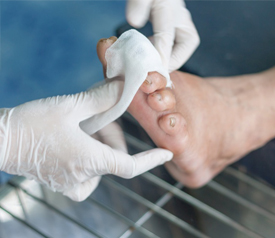
Seniors are in one of the highest risk categories for developing diabetic foot ulcers. These injuries cause painful, or sometimes numb, wounds on their feet due to blood flow issues brought on by their disease. Those who have diabetic foot ulcers must be extremely careful not to agitate the issues further.
Proper wound care is vital for seniors with diabetic foot ulcers. With the right skincare routine and bandaging, these ulcers can be managed and the patient’s life can be relatively normal and comfortable.
In this article, we’ll discuss a few statistics about diabetic foot ulcers (DFUs), helping seniors care for their DFUs, and how proper wound covering and taping are essential to long-term care.
What are diabetic foot ulcers?
A diabetic foot ulcer, or a DFU, is an ulcer on the body that is caused by blood vessel and neuropathy complications brought on by diabetes. These wounds often arise on the extremities and often on the foot.
High levels of blood glucose affect the body in a variety of ways. One effect of high blood sugar levels is the damaging of nerves and blood vessels. This can lead to tingling, stinging, or numbness on the body. The feet are most susceptible due to their distance from the heart and the constant weight and pressure they experience.
A diabetic foot ulcer causes major issues in everyday living. They make walking difficult due to the stinging pain caused by the damaged nerves. If the nerves are totally destroyed, numbness makes it very difficult to walk properly and safely. These ulcers are very problematic, especially for seniors, and they need to be cared for correctly.
Learn More: Podiatry & Wound Care Resources
A few statistics about diabetic foot ulcers
In 2015, a study was conducted to determine how many Americans currently suffer from diabetes. The numbers came back at over 30 million, or 9.4% of the population. Scientists expect these numbers to grow over time. Among the senior community, aged 65 and over, the number of diabetics reaches 12 million, or 25.2% of the population.
Diabetic foot ulcers are a major issue for those with diabetes. When a diabetic foot ulcer isn’t managed correctly, it can lead to serious complications. DFUs are the top risk factor contributing to foot amputations for those with diabetes.
Seniors with diabetes need to take care of their feet exceptionally well, whether or not they have a diabetic foot ulcer. Their disease can bring on a DFU very easily, so it’s vital for them to do what they can to avoid developing these ulcers.
For those who have developed a diabetic foot ulcer, all hope is not lost. With the right care, the DFU can be managed and the senior can walk fairly normally and comfortably.
Caring for a diabetic foot ulcer in a senior
Managing life with a diabetic foot ulcer can be tough but it’s not impossible. A few basic care tips can help seniors reduce their pain and live a normal life:
- Use moisturizer – DFUs can cause the feet to become very dry. Applying moisturizer regularly will help lock in more moisture and prevent further damage. Adding moisturizer every day before putting on socks or shoes is a good idea.
- Use diabetic socks – There are special socks that are designed to help those with diabetic foot ulcers. They are made with special materials that wick away moisture and hold tightly without adding stress to the foot. Diabetic socks can be a great tool in the fight to maintain foot comfort in a senior with a DFU.
- Use diabetic shoes – Much like socks, diabetic shoes are designed to help alleviate the pressure applied when walking. These shoes are typically made with softer materials and more padding than regular shoes. Wearing diabetic shoes when walking is ideal for a senior with a diabetic foot ulcer.
- Use wound dressings – As with any wound, applying a soft and protective wound dressing is ideal for handling DFUs. A doctor can recommend if certain creams or medicines should be applied to the foot before adding a dressing. Securing the dressing with a skin-sensitive tape such as Hy-Tape can help ensure maneuverability without pinching as well as a tight hold of the dressing.
The healing process for a diabetic foot ulcer can be long, and in some cases, they will not heal fully. Taking these precautions makes it easier for the wound to heal and for the senior to walk normally.
Using Hy-tape can reduce complications
When it comes to wound dressings for a diabetic foot ulcer, taping the dressing in place correctly is vital. Using Hy-Tape is the best option for securing a wound dressing.
Hy-Tape is specially designed to hold tightly without pinching or chafing the skin. The adhesive is made to hold well to the skin but also featured zinc-oxide, a skincare element commonly found in sunscreen. This helps ensure that the tape holds well but does not irritate the skin, especially when being removed and replaced.
Whether you are a senior living with a diabetic foot ulcer or a caregiver managing a senior’s DFU, be sure to use Hy-Tape to secure the wound dressing. Contact us today to learn more about how Hy-Tape can make DFU management much easier.
Learn more about Diabetic Foot Ulcer care and prevention:
- Diabetic Foot Ulcers: Topical Management Strategies
- Diabetic Foot Ulcers: Management of Common Problems
- Negative Pressure Wound Therapy: A Focus on Diabetic Foot Wounds
- Proper Care for Diabetic Ulcers and Sores
- Costs of Long-Term Diabetic Wound Care
- Lower Extremity Wounds: Wound Dressings Strategies in Managing Venous, Arterial, and Diabetic Ulcers
- White Paper: Wound Dressings Strategies in Managing Venous, Arterial, and Diabetic Ulcers

